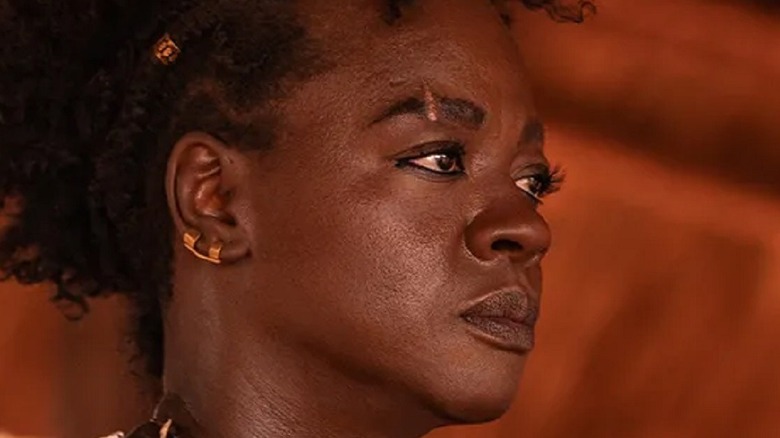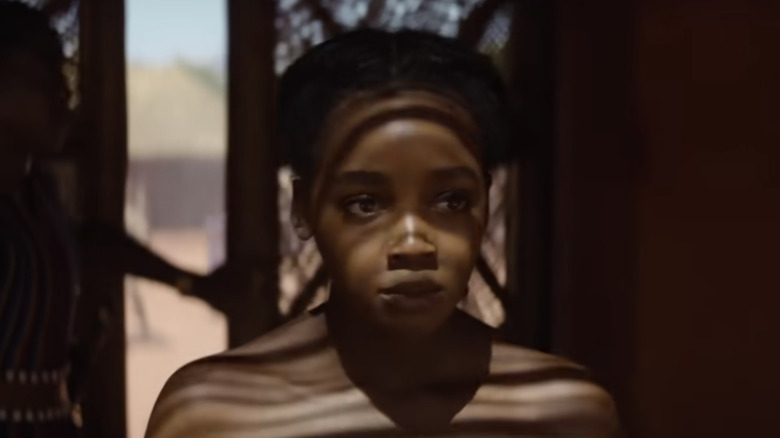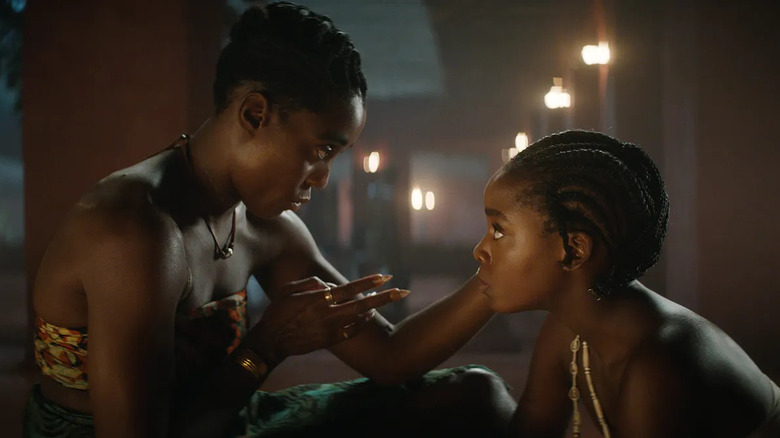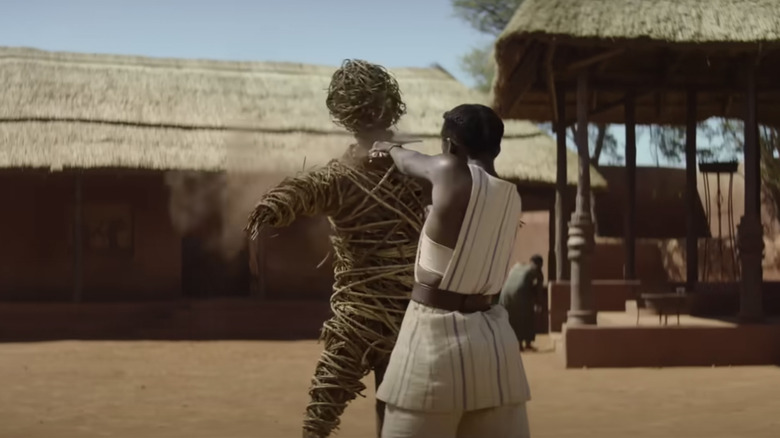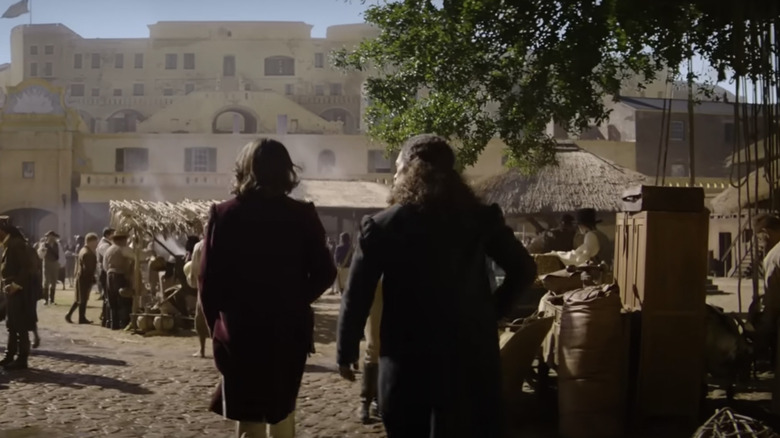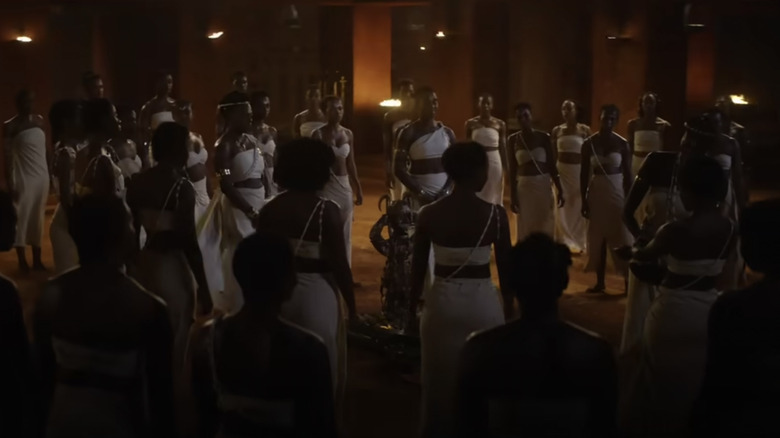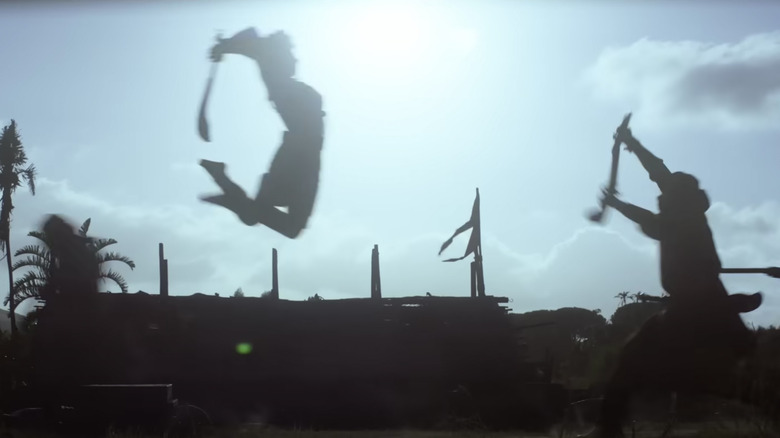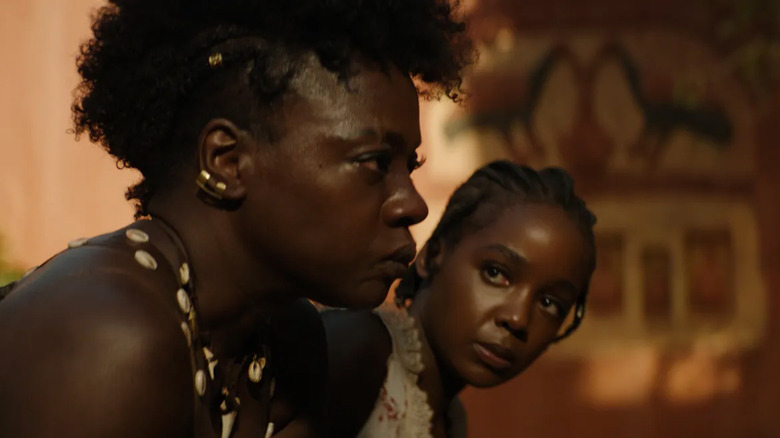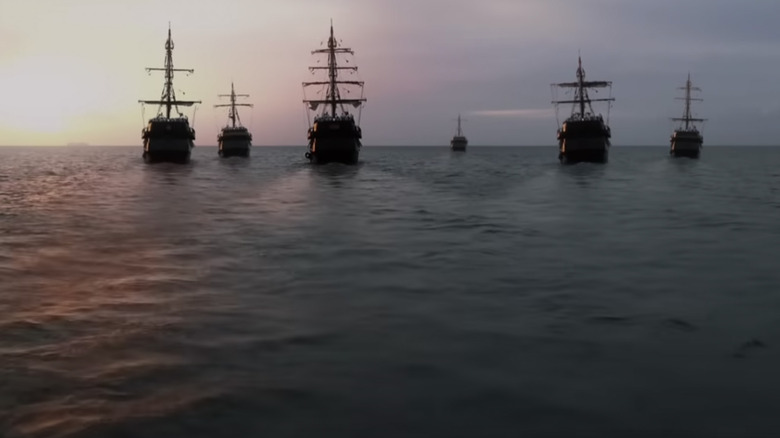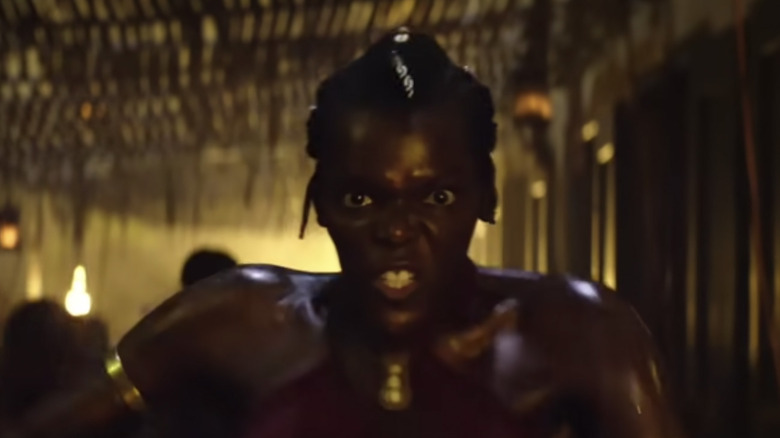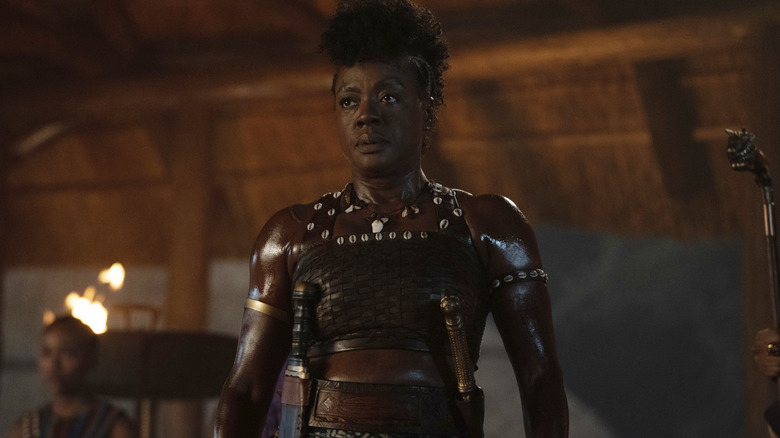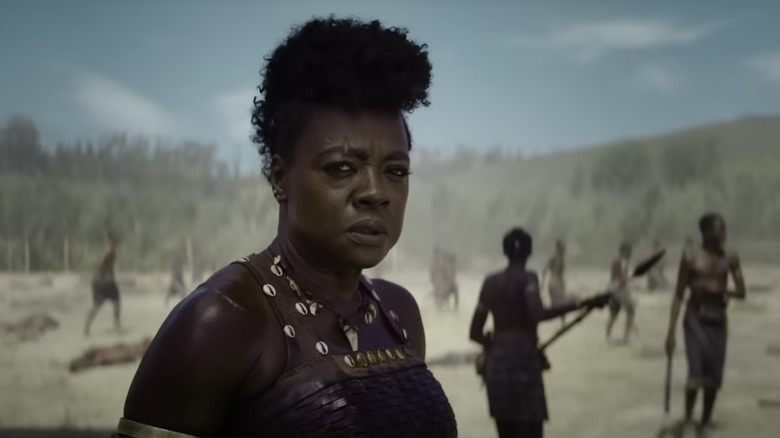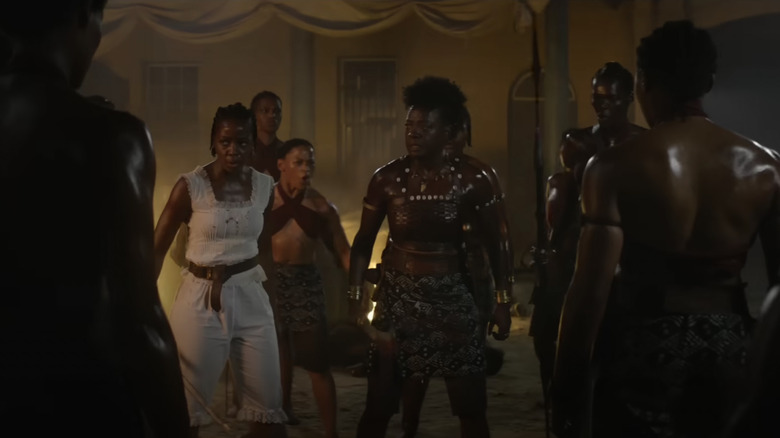The Woman King's 12 Most Memorable Scenes Ranked
"The Woman King" offers a historical epic that's fantastically entertaining even if it's not exactly historically accurate, and you don't get an entertaining movie without great scenes. Here we'd like to take a look at some of the most memorable moments in a movie filled with them. The film is so full of subplots that it's hard to pick what storylines we really found most memorable, but it's easy to know what scenes have stuck with us.
And because the Gina Prince-Bythwood-directed movie offers so many stories within its larger narrative about the Agojie warriors defending the kingdom of Dahomey against the Oyo and European slave traders the most memorable scenes vary greatly from one another. Some of them are sweet, some of them are funny, some are astounding sequences of action, and some are emotionally devastating. But even knowing that, there are still so many scenes in the film that have those impacts, and because we can't help ourselves, we'll rank the scenes based on their impact. So without further ado, let's dive into the 12 most memorable scenes in "The Woman King," ranked.
Spoilers ahead for "The Woman King."
12. The final test
The timeline of training for new recruits into the Agojie isn't exactly clear, but there can be no doubts about the intensity of their training. And once that training is complete, the young women must face a final test to take their place among the feared and revered women warriors.
That test consists of a number of trials, strung together in a brutal obstacle course. The recruits must make their way through a bramble of thorns, over a battlement, and pass a group of infantrymen determined to stop them. The test would be thrilling to watch no matter what, but the scene becomes even more exciting and memorable when Nawi (Thuso Mbedu) turns back after the first obstacle.
Her friend is stuck in the thorns and even though Nawi has made it through, she reenters the bramble so that she can help free her friend and they can both make it to the end of the test. Turning back of course sets Nawi back in the course, leading her to make some rash decisions to make up time, like leaping from the top of the battlement instead of climbing down.
The scene isn't just thrilling, but it also highlights an aspect of Nawi's character. She is headstrong and willing to do things differently to help her friends, even if it means setting herself back. But she's also willing to sacrifice her body to achieve glory for herself.
11. The first rule of training is always obey Izogie
When Nawi first arrives at the palace to join the Agojie, she is greeted by Izogie (Lashana Lynch), one of the fiercest Agojie warriors. But Izogie is also kind and caring, she wants every recruit to do well and become a celebrated warrior like her. After taking Nawi on a brief tour of the palace grounds, which double as the training area for the Agojie, Izogie leaves Nawi to acclimate herself.
But when the two see each other again, Izogie is shocked at how dirty Nawi is, and she asks the girl why she hasn't bathed since arriving. Nawi says she wants to let the senior women bathe first, but Izogie tells her that there is one major rule of training — the first rule, in fact — and that that rule is: "Always obey Izogie." Nawi nods to show that she has understood and will follow this rule, but she doesn't move. Izogie then has to say "I'm Izogie" for Nawi to get the message that Izogie, who must always be obeyed, is telling her to shower.
It's a sweet moment that sets up their relationship for the rest of the film. Izogie is a stern but loving mentor who will push Nawi to be her best self, in combat and in cleanliness, but she will always do so with care and humor.
10. Training with a rope
One of the first training tasks for new recruits to the Agojie is to work with rope and create a lasso from the piece of rope they are given. Some of the girls are able to do this easily — others, including Nawi, struggle. This method of training itself isn't very memorable, what makes the scene memorable is how Agojie leader General Nanisca (Viola Davis) responds to Nawi's complaint that a rope isn't even a weapon.
Nanisca offers Nawi her sword, which Nawi can barely lift because it's so heavy, and instructs the young woman to take the head off of a training dummy. Nawi is hesitant, but Nanisca tells her that if she wants to use a real weapon she should take the opportunity. So Nawi attacks the dummy, swings the large sword at its neck, and firmly lodges the sword in the dummy without removing its head or damaging it much at all.
Nanisca calmly walks over, removes the sword, and powerfully swings it, removing the dummy's head in a single blow. She then sheaths her sword and tells Nawi to practice with the rope. As with the scene with Izogie, this scene shows the kinds of leaders the more experienced Agojie are, they will tell the recruits their place, but they will do so with some joy instead of harsh discipline.
9. Nawi steals Malik's clothes
Malik (Jordan Bolger) is the son of a European man and a Dahomey woman who has grown up in the Portuguese colony of Brazil and comes to West Africa with his friend, slaver Santo (Hero Fiennes Tiffin), to see his mother's home and her people. Shortly after arriving, as he and Santo are making their way to Dahomey, he decides to take a swim in a pond. But when he gets out his clothes have gone missing.
He initially thinks that his friend is playing a trick on him and requests his clothes back, only to discover that in fact, it's a beautiful young woman who has taken his clothes and seems to threaten him. But when he responds to her in her language the two find a rapport as he explains his heritage and his desire to see Dahomey. It's also clear that the two feel an attraction, one that's easy for the audience to understand given that Malik is in very good shape and quite good-looking.
It's a funny scene that sets off the romantic subplot in the film and makes clear, beyond the fact that they're both attractive, why Nawi and Malik become attracted to one another.
8. The blood oath
Once Nawi and her fellow recruits have completed their final test and proved themselves worthy of joining the elite Agojie, they are entered into the group through a blood oath ritual. We're used to seeing communities make blood oaths in horror movies, but those are usually very ominous affairs. What's so memorable about the blood oath in "The Woman King" is that it's a joyous occasion.
We see the women who have been members of the Agojie for years collect blood from the young women who passed the test earlier that day, bringing it all into a ceremonial bowl. But it's not only the young women who have just joined the ranks of the Agojie that day who contribute to the blood in the bowl — all of the women, including General Nanisca, contribute.
The blood oath scene is beautiful and atmospheric and a moment of celebration for the young women who are now seen as a part of the fighting elite for their kingdom. They are now on equal footing with their mentors and they all bind themselves to one another through this ceremony.
7. Termite hill explosions
In an early scene during training, Nawi and some of her friends play a prank on the older Agojie by lining dummy's necks with gunpowder and creating a spark when the senior members knock off the dummy's heads. At the moment, it seems as though this trick is a disappointment to Nanisca, but as the movie goes on, it gives her an idea.
When the Agojie and other citizens of Dahomey learn from Malik that Oyo plans to attack, they begin to prepare themselves to attack first and retake the advantage of the element of surprise. Using gunpowder without guns as Nawi told Nanisca was possible, the Dahomey warriors create fake termite hills filled with gunpowder that they are then able to alight using a gunpowder wick.
When the Dahomey make their attack, the explosions have the perfect effect and are also just a joy for the audience. They explode brightly and shockingly with shrapnel flying into the Oyo camp, announcing that the Dahomey are not sitting ducks to be attacked lightly.
6. Nawi is Nanisca's daughter
In one of the darker subplots of "The Woman King," we learn that many years ago, Nanisca was captured by the Oyo and repeatedly sexually assaulted during that capture. When she finally escaped, she was pregnant.
She brought the pregnancy to term and asked her trusted friend Amenza (Sheila Atim) to get the baby out of Dahomey, but ensure that it would be safe. But before parting with the child, she embedded a shark tooth in the baby's shoulder, so that if the child ever found its way back to her, she would know.
When Nanisca discovers a large scar on Nawi's shoulder and that Nawi was adopted by the family that raised her, she begins to suspect that Nawi may be her daughter. Amenza ensures her it's not possible, but one night, when Nanisca and Nawi are the only ones in the baths, Nanisca inspects Nawi's shoulder wound, cutting it open and revealing the shark tooth.
It's a somewhat melodramatic moment, but Davis and Mbedu's performances thoroughly sell the emotional reality of the discovery, making it one of the most memorable scenes in the movie.
If you or anyone you know has been a victim of sexual assault, help is available. Visit the Rape, Abuse & Incest National Network website or contact RAINN's National Helpline at 1-800-656-HOPE (4673).
5. Malik frees chained men
The climax of "The Woman King" is a multifaceted nighttime battle in the port city where slavers arrive. As the Agojie and their male counterparts in the Dahomey infantry attack, chaos erupts, and Santo recognizes that it's time for him and his human cargo to get out of Africa before things change for him.
Santo takes a small group of African men, bound together by chains and ropes, and attempts to get them off the mainland and onto a ship so that he can sell them. Malik is with him as he does all this, but we can see that Malik is troubled by the idea of enslaving these people whom he shares blood with.
In a moment of bravery, Malik frees the chained men and allows them to take their revenge on Santo without interfering. It's a powerful moment and the end of Malik's identity struggle, he knows what is right, and he has chosen to act to help his African people. The scene ends with a potent image of Santo's unconscious, and possibly dead, body washing in the surf.
4. Amenza kills a slaver with chains
During the film's climax, we get to see a number of different characters engage in thrilling combat against the Oyo and slavers as part of their night raid on the port city. But the best piece of the action, both in terms of excitement and meaningful imagery, is when Amenza kills a slaver with chains.
She grabs a chain that has presumably been used to hold other Africans captive, and at first swings it at the white man before getting closer, wrapping it around her hand and beating him with it. It's a surprisingly brutal scene in a movie that's rated PG-13, but it's also incredibly satisfying. The power of the image of an African woman killing a white slaver with the same chains that he used to enslave her fellow Africans cannot be overstated. And Atim's performance is so fierce and full of rage that watching it's clear this is not lost on Amenza as she kills him.
3. Nanisca is named Woman King
After leading the raid on the port city to free the members of the Agojie as well as Africans who are not Dahomey from the slave traders, Nanisca and her soldiers return to Dahomey expecting to be disciplined by their king Ghezo (John Boyega), who explicitly forbade Nanisca from leaving the city the night before. But when they return, with a group of freed Africans in tow, Ghezo is overcome by admiration for Nanisca's bravery and principles.
He had already decided to name her Woman King, a position that would sit alongside him offering a gendered balance to the rule of Dahomey, but when he first tells her this, she is desperate to free the enslaved Agojie, including her daughter Nawi. He tells her that he wants her to remain here, to take this honor at his side, but that if she disobeys him he will have no choice but to look her over.
And yet, despite the fact that the disobeys his order, her actions are so clearly heroic that he cannot consider anyone else for the role. He gives a speech about her bravery and success as a leader and announces her the Woman King of Dahomey, offering her a throne of her own at his side.
2. Nanisca tells Oba he will not forget
When Oba (Jimmy Odukoya), the leader of the Oyo army, first arrives in Dahomey early in the movie to demand tribute from the kingdom, Nanisca recognizes him as one of the men who sexually assaulted her during her captivity. That recognition makes her desire to kill him, not only a political desire for her country's war against the Oyo, but an absolutely understandable personal vendetta.
The two come to blows a few times throughout the movie, but all of these battles end as stalemates as one of them (and their fellow soldiers) make the strategic decisions to retreat. But in the film's climactic battle, Nanisca finally has her revenge. The fight between the two is exciting and often frightening to watch as there is a real push and pull over who has the upper hand at any time.
But in the final moments of the fight, Nanisca is literally able to turn Oyo's own knife towards him and stab him with it. She asks if had forgotten her, before forcefully pushing the blade deeper into his sternum, staring him in the eyes and declaring "you will not forget" as he dies. It's another moment that's somewhat shocking in its brutality, but equally satisfying.
If you or anyone you know has been a victim of sexual assault, help is available. Visit the Rape, Abuse & Incest National Network website or contact RAINN's National Helpline at 1-800-656-HOPE (4673).
1. Nawi saves her mother
Right after Nanisca finally takes down Oba, she is made the target of a slaver's rifle. She doesn't have a moment to celebrate — this is battle, after all — and for a moment it seems as though her well-earned revenge will be her last moment alive. But then the slaver is shot from behind, and as the slaver falls, the camera reveals Nawi holding a pistol.
There's of course the immediate relief that one of our heroes has been saved and didn't die seconds after taking her revenge, but the moment is memorable for more than just that. Nawi and Nanisca have had a fraught relationship since Nawi joined the Agojie, and that did not become any simpler when the two learned that Nawi is Nanisca's daughter. There has been a battle for respect between the two as Nanisca fears that Nawi's arrogance and single-mindedness may be a danger to her and her fellow Agojie.
But at this moment, Nanisca realizes that all her daughter has ever been driven by was love and care for her comrades. It also highlights that Nawi is an indispensable member of the Agojie, willing to make unorthodox decisions to keep her fellow soldiers safe and to win battles, something that was foreshadowed by the use of the exploding termite hills earlier in the film.
It's a narrative and emotional beat that brings together many of the film's multiple subplots and storylines in a beautiful moment of recognition and admiration between mother and daughter.
